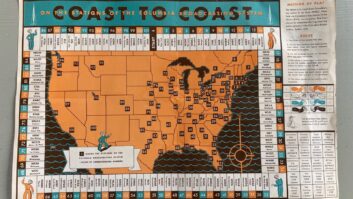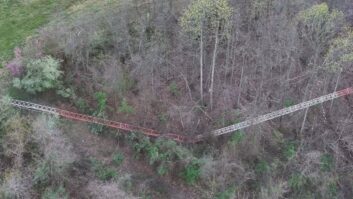On Location: Old-time Radio In a Modern Era
Jul 1, 2002 12:00 PM, By Ron Bartlebaugh, CBNT
The spirit of the live radio variety shows that were so popular in the 30�s and 40�s is captured in the WCLV production. This photo, from the collection of Larry Kass, shows Ruth Etting, a popular radio singer of the 30�s as she sings into a microphone that is now part of the John Milton Williams Museum.

The audience is seated. The actors are standing by and the Theater of the Air Chorus is in place. The sound effects man is ready to go. The mighty Wurlitzer pipe organ sits center stage beside its companion 1927 Steinway Duo-Art grand piano. The curtain’s going up. It’s time for The Mighty Wurlitzer Radio Hour program to originate live on WCLV-AM and FM from the home of the John Milton Williams Museum of Radio Broadcasting History. Perhaps America’s only live musical variety program on the air takes audiences back to the Golden Age of radio.
The radio program was the idea of WCLV President and long time radio voice of the Cleveland Orchestra Robert Conrad, and accomplished physician and organist/pianist Kass. Conrad has been involved in fine arts radio for several decades. Larry Kass started as a classical pianist at age five and made his radio debut on an amateur show on WSPD in Toledo, OH. At the age of 15, Kass was the piano soloist with the Toledo Orchestra in Gershwin’s Rhapsody in Blue. Cleveland’s legendary radio celebrity, Wayne Mack, wrote and directed The Mighty Wurlitzer Radio Hour programs for several years beginning in 1993. Mack’s radio career began in 1931 on WJAY in Cleveland. Over a period of 68 years, Mack wrote thousands of original radio scripts and produced and directed local and national radio shows for WGAR in Cleveland and also for the Columbia Broadcasting System. Professional actors, vocalists, instrumentalists and legendary announcers have been used on The Mighty Wurlitzer Radio Hour shows since 2001.
The Mighty Wurlitzer Hour takes to the airwaves.

More than a dozen of the fast moving programs, each containing more than 20 songs, were taped before a live audience and tape-delay aired on WCLV before the show went live to air in October of 2001. Radio history was then made in northern Ohio when The Mighty Wurlitzer Radio Hour played before a live studio audience and was broadcast simultaneously over WCLV AM/FM as well as on www.wclv.com. The program was a musical variety show that celebrated the Golden Age of Radio as part of the dedication of the John Milton Williams Museum of Radio Broadcasting History. The museum is an exhibition of rare microphones and one of a kind memorabilia from the early days of radio broadcasting through the Golden Age of Radio in the 1930s and 1940s. Each show brings back memories of live radio in a high-class format that includes classical music and the best of vintage American popular music by composers such as Irving Berlin, Cole Porter and Glenn Miller. It is said that the program is the way radio was intended to be. A second show has aired live since the October 2001 program and several more are planned. The show scheduled for June 30 was to have a patriotic theme as it will air close to Independence Day. The fall program, scheduled for October 6 at 3 p.m., and the Christmas program, scheduled for December 15 at 7 p.m., will each contain a seasonal theme. All shows, beginning with the October 2001 airing, were or will be performed before a 100-person studio audience and broadcast live over WCLV-AM/FM and online at www.wclv.com.
Two Shure SM81 mics are set up in an X-Y configuration to pick up the chorus. An Electro-Voice RE-20 is mounted below the X-Y to act as a middle fill and to pick up the actors� voices.

The Mighty Wurlitzer Theater pipe organ’s life began in 1928 as it entertained the opening night audience at the opulent Plaza Theater in Kansas City, MO. Even though the organ remained in nearly pristine condition over the years, it was restored starting in 1965 and finished in 1987 by Ronald Wehmeier of Cincinnati. Kass, and architect-wife Sara, purchased the organ in 1987 and subsequently had it installed in their home in an area that was specially created by Sara. The 1927 Steinway grand piano, which is positioned adjacent to the organ console, was added in 1994 and can be played from each manual and the pedal keyboard of the organ. The Wurlitzer has two manuals and 19 ranks of pipes. Its 1,315 pipes are contained in two subterranean chambers that are 15-feet high and kept at 70 degrees F and 45 percent humidity to maintain proper tuning of the organ. The sound of the organ travels through swell shades located in the floor above the chambers. The use of the shades provides a quality acoustical alignment of the organ sound. The opening and closing of the swell shade’s louvers determine the volume of the organ and are controlled by the organ’s pedals. A rare1927 Wurlitzer vibraphone is located between the organ console and the swell shades and can be frequently heard blending with the wide dynamic sounds of the organ as it all transverses to the audience through a specially designed acoustically correct room. The organ has all of the special sound effects that were used when instruments of this type accompanied the screening of silent movies. Some of those effects include clanging bells, boat whistles, and automobile horns. Other special effects include a bird whistle, a fire bell, a quacking duck and a train whistle. The chambers also contain many orchestral and percussion instruments that are played from the organ’s console.
The Wurlitzer organ and Steinway piano provide the instrumental accompaniment during the performances.

Capturing the sound
Two AKG 225 microphones are located above the swell shades in a spaced pair for miking the organ for broadcast. These microphones were specifically chosen for use by Kass because of their low frequency response and capacity to reproduce the smooth mellow mid range sounds of the organ. Two Shure SM81 microphones are used on the stage in a X-Y pair for middle fill of the organ miking as well as for miking the Theater of the Air Chorus. An Electro-Voice RE-20 microphone is located below the x-y pair for filling in the middle of the X-Y pair as well as for miking the actors. A Shure SM57 microphone is used by the announcers. The Steinway grand piano is miked by using two Audio Technica AT4031 microphones in a spaced pair configuration that are located about three feet from the piano.
No prerecorded sound effects are used on the show. All sound effects used are created by newly built replica of an old-time sound effects box complete with a squeaky hinge, slamming door and a resonating chamber that is used to create a knock on the door effect. Program engineer James Patrick Murphy uses two Shure SM57 microphones for miking the sound effects box; one above, and one below the box. Everything is close miked due to the limited space of the room.
WCLV president Robert Conrad serves as the program�s host. Vintage mics from the museum�s collection are set up in front of the performers for dramatic effect. Conrad�s actual mic is a Shure SM57, which is visible behind his script.

A Mackie 1604 16-channel mixing console derives the mix that is fed to WCLV via a Telos Zephyr ISDN codec. The program is also recorded on multiple media formats including mini-disc, hard drive and DAT. Compressor-limiters are not used in favor of manual gain riding. A pair of self-powered JBL EM15 speakers mounted on stands provide the public address system for the audience.
A taste of history
Many of the broadcast microphones are hidden behind antique microphones from the on-site John Milton Williams Museum of Radio Broadcasting History to enhance the perceived effect of an old time radio theater. The museum is just down the hall from the Mighty Wurlitzer Radio Hour studio. Its collection was originally part of a display within the NBC Exhibit Hall of the RCA Pavilion at the 1939 New York World’s Fair. The collection was later rescued from demise by Joseph D’Agostino and later entrusted to his close friend John Milton Williams who was a successful radio announcer, actor and a collector of radio memorabilia. Kass and his wife acquired the entire collection in 1999.
Announcer Jim Mehrling checks the script with Larry Kass.

One of the nearly two-dozen microphones that are on display is a circa 1930 Western Electric condenser microphone with the Columbia flag fixed to the long dimension of the microphone. Another is a telephone-type ring microphone used by Dr. Frank Conrad on 8XK (later becoming KDKA) in 1919. Other items of interest on display at the museum are the original NBC chimes that were used in 1922 at WGY, Schenectady, NY.
Artifacts relating to early wireless communications and telegraphy that were collected by D’Agostino and Williams are also on display, including a rare DeForest single wing Audion tube circa 1927 that, as simple as it is by today’s standards, causes one to marvel at the �new� technology of that era. A Marconi valve circa 1915 sits proudly on display in the museum as another memory of days long past.
Many of the same microphones that are on display in the museum were once used by actors and singers during the Golden Days of radio on programs such as the Atwater Kent Hour, The Eveready Hour and The Lux Radio Theater. The singers and actors on The Mighty Wurlitzer Radio Hour perform in harmony with the heart and soul of the Wurlitzer pipe organ to bring life to the memories of those Golden Days. It is a touch of days long past, but not forgotten, thanks to The Mighty Wurlitzer Radio Hour, America’s only live musical variety program on the air, and the John Milton Williams Museum of Radio Broadcasting History.
Bartlebaugh is director of engineering for the WKSU stations, Kent, OH, and president of Audio and Broadcast Specialists, Akron, OH.
More online
To listen to the Mighty Wurlitzer Radio Hour online go to www.wclv.com and click on Archived Audio and then Specials.
You can also see more photos of the Mighty Wurlitzer Radio Hour accompanying this story online at www.beradio.com.










